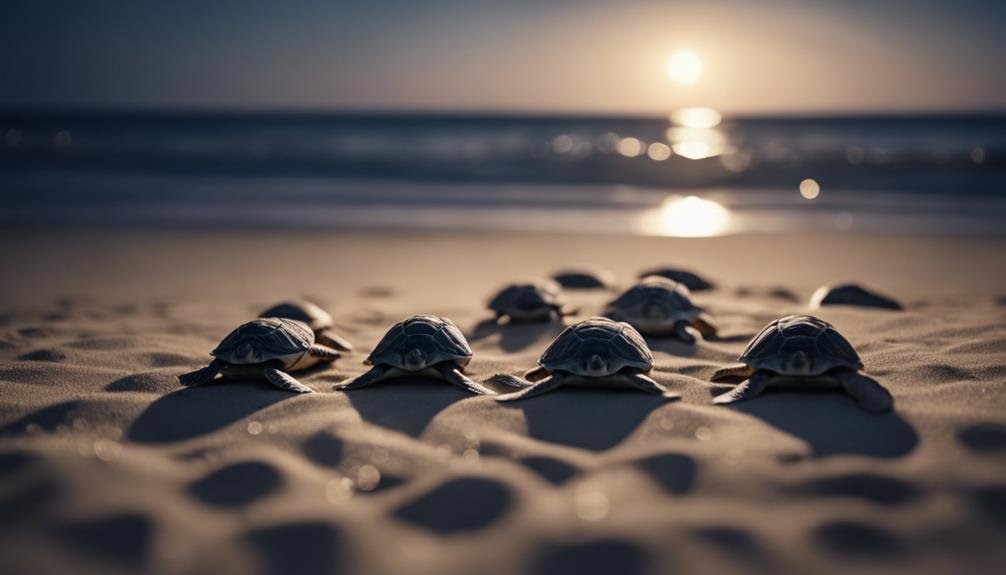Have you ever wondered about the reproductive habits of sea turtles and how many eggs they lay? Depending on the species, you’d find a fascinating range from 50 to over 200 eggs per clutch. While leatherback turtles might seem less prolific with around 50 eggs, hawksbill turtles can astonish you with more than 200 eggs in a single nest. Considering they can lay multiple clutches in a season, the overall contribution to their population is significant. But there’s more to this story than just numbers. The survival challenges these eggs face from the moment they’re laid until the hatchlings make their perilous journey to the sea are compelling, and understanding these aspects is vital for their conservation.
Key Takeaways
- Sea turtles lay 6-10 clutches of eggs each season.
- Clutches contain 80-180 eggs on average.
- Hawksbill turtles produce the largest clutches, depositing over 200 eggs in a nest.
- Leatherback turtles lay the smallest clutches, with around 50 eggs per clutch.
- A single sea turtle might lay up to 12 nests in a season, varying by species.
Sea Turtle Nesting Habits
Across the globe, sea turtles exhibit fascinating nesting habits, laying between 6-10 clutches of eggs each season in carefully selected sites. These clutches contain a significant number of eggs, usually ranging from 80-180 eggs per clutch. You’ll find that during the nesting season, which varies among species, these marine creatures are incredibly diligent in ensuring the survival of their future offspring.
Hawksbill turtles, in particular, are known for producing the largest clutches, with nests containing up to 140-160 eggs. This is a reflection of the remarkable efforts these creatures make to preserve their species. The nesting season is a critical time for sea turtles, as it determines the future population of these majestic creatures. Some species lay eggs annually, while others do so every other year, adapting their reproductive cycles to their environment and the challenges they face.
As you explore the world of sea turtles, you’ll be amazed by their commitment during the nesting season. Their ability to produce multiple clutches of eggs and the sheer quantity of eggs per clutch are key aspects of their survival strategy. Hawksbill turtles, with their larger clutches, highlight the diversity and adaptability of nesting habits within the sea turtle community.
Egg Count by Species
Building on our understanding of sea turtle nesting habits, let’s examine the specific number of eggs different species lay per clutch. Each species of sea turtle has its unique nesting behavior, which includes the number of eggs they deposit in a single clutch. This aspect is vital for their survival, making it an interesting point of study.
Here’s a quick overview of the egg count by species:
| Species | Eggs per Clutch | Nesting Season Clutches |
|---|---|---|
| Leatherback | Around 50 | 2 to 8 |
| Hawksbill | Over 200 | 2 to 8 |
| Green | Average of 110 | 2 to 8 |
Leatherback turtles, known for their vast migrations, lay the smallest clutches among sea turtles, averaging around 50 eggs. In contrast, Hawksbill turtles, with their beautifully patterned shells, lay the largest clutches, sometimes depositing over 200 eggs in a nest. Green turtles, easily identifiable by their large, smooth carapaces, lay an average of 110 eggs per nest. Importantly, the number of nests a sea turtle lays in a nesting season varies, with Leatherbacks on the lower end and Hawksbills often laying the most. This variation in egg count and nesting behavior highlights the diversity and complexity of sea turtle reproduction.
Nesting Sites Selection
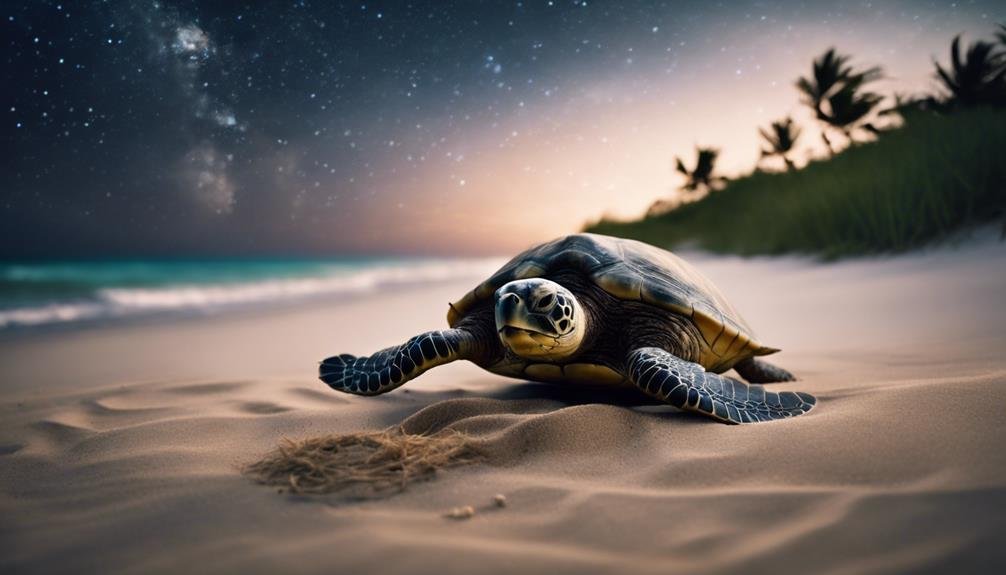

Sea turtles meticulously choose dark and secluded beaches for their nesting sites, ensuring a safe environment for their eggs. They prefer the calmness of dark and quiet surroundings, away from the disturbances of light and noise that could deter their delicate process. You’ll find them using their rear flippers with striking dexterity to dig nests above the high water mark, safeguarding their future offspring from being washed away by high tides.
The clutch size, or the number of eggs laid, varies greatly among species. For instance, leatherback turtles, known for their massive size, lay around 110 eggs per clutch. However, it’s the hawksbill turtles that often have the largest clutches, depositing a remarkable 140-160 eggs in a single nest. This variance in clutch size among species highlights the diversity and adaptability of sea turtles to their environments.
The selection of nesting sites is a critical stage in the life cycle of sea turtles. It’s not just about finding a spot on the beach; it’s about securing a future for their offspring. The dark and quiet beaches they seek aren’t merely a preference but a necessity for the survival of their species.
Incubation Period Details
Once the eggs are laid, they begin an average incubation journey of about 60 days, a period that’s vital for their development into hatchlings. The exact duration of this incubation period can greatly influence the development of sea turtle eggs, making temperature and species two key factors in their successful hatching.
Here’s what you need to know about the incubation period:
- Varies by Species: Depending on the species of sea turtle, the incubation period can vary slightly. Some species might hatch a bit sooner or later than the 60-day average.
- Temperature Plays a Role: Warmer temperatures tend to accelerate the incubation process, potentially shortening the time it takes for the eggs to hatch.
- Cooler Temperatures Slow Things Down: Conversely, cooler temperatures can prolong the incubation period, delaying the development and hatching of the embryos.
- Critical for Development: This incubation time isn’t just about waiting; it’s a critical phase for the embryos to develop properly into healthy hatchlings.
Understanding the intricacies of the incubation period helps in appreciating the delicate balance required for the successful hatching and survival of sea turtle eggs.
Temperature and Gender Link
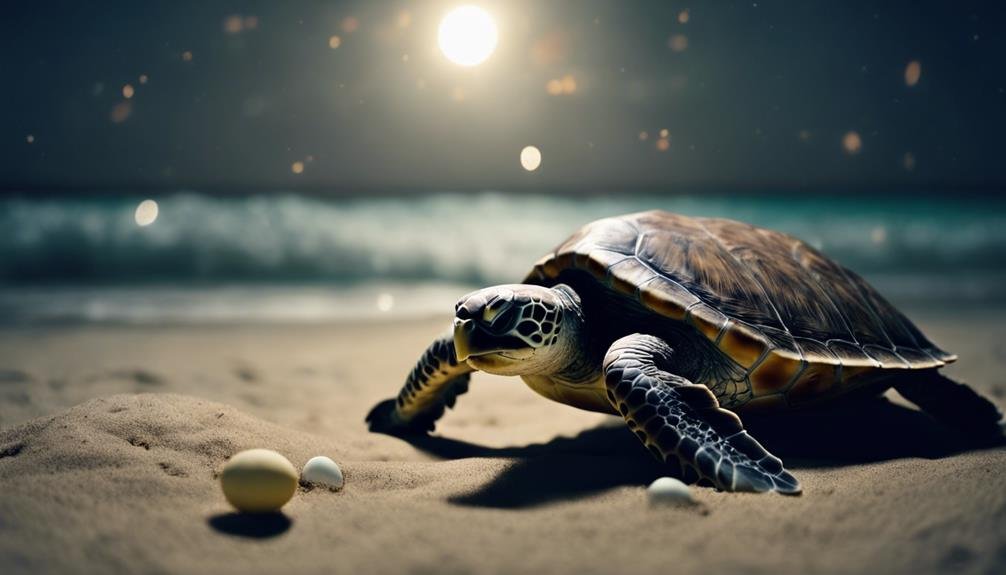

Fascinatingly, the temperature of the sand where sea turtles lay their eggs plays a crucial role in determining the gender of the hatchlings. This phenomenon, known as Temperature-Dependent Sex Determination (TSD), shows that cooler sand temperatures during incubation tend to produce more male sea turtles. Conversely, when the sand heats up, you’re more likely to see a higher ratio of female sea turtles emerging. This intriguing aspect of sea turtle biology means that the very beaches these ancient creatures have used for millions of years to nest and hatch could dictate their gender distribution.
The implications of climate change on this process are profound. As global temperatures rise, sand temperatures do too, potentially skewing the natural gender balance of sea turtle populations towards females. This shift could have significant effects on their genetic diversity and long-term survival. It’s a stark reminder of how interconnected our planet’s systems are, with changes in one area rippling out to touch others in ways we’re just beginning to understand. As you learn about sea turtles, it becomes clear that their future is intricately linked to our actions and the broader climate challenges we face globally.
Egg Laying Process
Diving into the egg-laying process, female sea turtles begin an extraordinary journey back to their birth beaches to nest and lay their eggs, with the number varying greatly across different species. This pivotal moment in a sea turtle’s life is fascinating, especially when you consider the effort it takes to guarantee the continuation of their species. Here’s a closer look at what this process involves:
- Clutch Size: The number of eggs sea turtles lay can range greatly. For instance, leatherback turtles lay about 110 eggs per clutch, while hawksbill turtles may lay between 140-160 eggs.
- Frequency: Sea turtles don’t lay eggs annually. They do so once every 2-3 years, though some species have been known to nest annually or biennially.
- Nesting Season: During the nesting season, a single sea turtle might lay up to 12 nests, a confirmation of their incredible reproductive effort.
- Variability by Species: The total number of eggs laid in a season isn’t just about biology; it’s also tied to the species, with each having its own typical range.
Understanding the egg-laying process of sea turtles offers insight into their reproductive strategies and the challenges they face during nesting season.
Threats to Sea Turtle Eggs
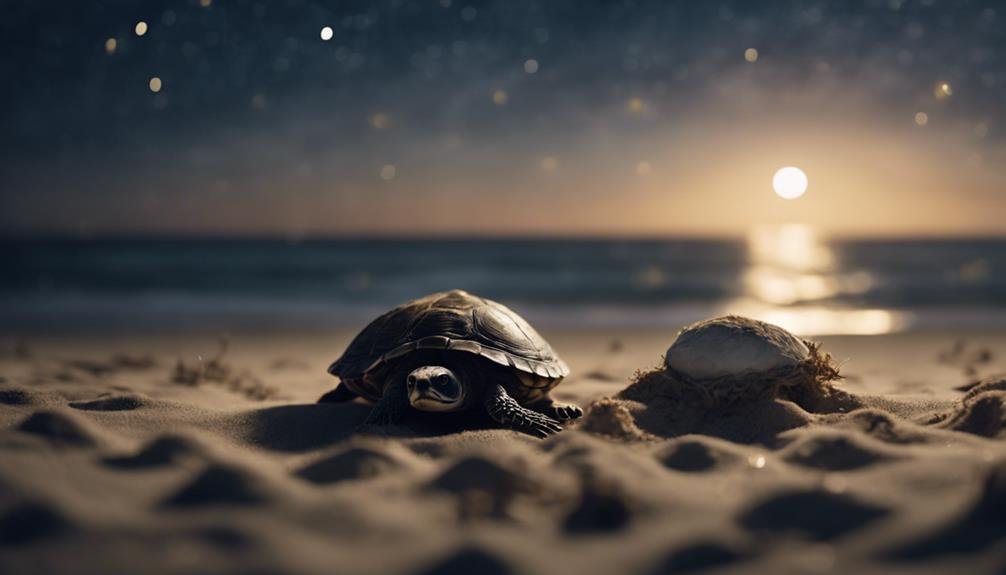

Despite their remarkable journey, sea turtle eggs are vulnerable to several threats that jeopardize their survival. Predators such as crabs, ants, raccoons, and birds eagerly await the chance to feast on these eggs. But it’s not just the natural predators you’ve got to worry about. Human predation plays a significant role, too. People often harvest sea turtle eggs and shells, severely threatening the nests’ safety and the future of these majestic creatures.
Furthermore, coastal development has become a pressing issue. As beaches are built up, the nesting habitats of sea turtles are disrupted, making their eggs even more vulnerable. This isn’t helped by the fact that plastic ingestion is on the rise. Sea turtles, mistaking plastic for food, ingest it, which can harm the eggs and their chances of survival.
And let’s not forget about artificial lighting. It’s a big problem for hatchlings. Lights from buildings and streets near nesting beaches can disorient them, steering them away from the sea. This confusion affects the success of sea turtle nests, as many hatchlings don’t make it to the ocean.
Conservation Efforts
Acknowledging the myriad threats to their survival, efforts to conserve sea turtles focus on protecting their nesting beaches and reducing bycatch through innovative solutions. You’re part of a global community that values the existence and well-being of these ancient mariners. Understanding the critical conservation measures in place can empower you to contribute more effectively to their survival.
Here’s how conservation efforts are making a difference:
- Monitoring and Protecting Nesting Beaches: By keeping a close watch on nesting beaches, conservationists can guard against poaching and habitat destruction. This safeguards that more hatchlings have a chance to make it to the sea.
- Utilizing Turtle Excluder Devices (TEDs): TEDs allow sea turtles to escape from fishing nets, greatly reducing bycatch. This innovation has been a game-changer for sea turtle conservation.
- Launching Public Awareness Campaigns: By raising awareness, individuals and communities learn about the importance of sea turtles to marine ecosystems and are motivated to participate in conservation efforts.
- Operating Rehabilitation Centers: These centers provide care for injured and sick sea turtles, helping them recover and return to their natural habitat whenever possible.
Your awareness and involvement in sea turtle conservation, from supporting nesting beaches to advocating for the use of Turtle Excluder Devices, play an essential role in the fight to preserve these magnificent creatures for future generations.
Hatchling Journey to Sea
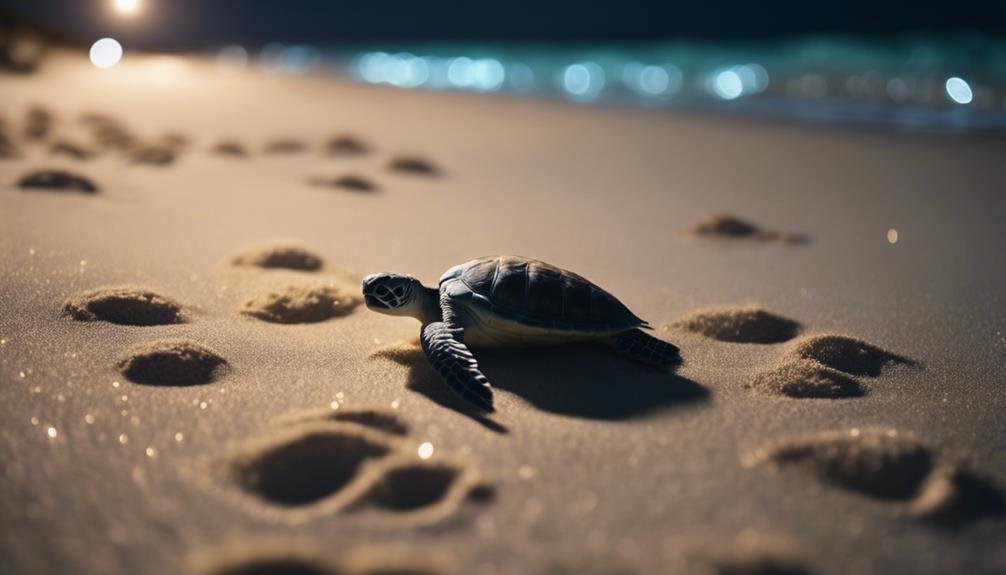

Upon emerging, sea turtle hatchlings set out on a perilous journey to the sea, journeying together to outmaneuver predators waiting along the shore. This synchronized journey begins when they hatch in unison, resembling a pot of boiling water in their sandy nest. You can imagine the sight as dozens, sometimes hundreds, of tiny turtles break free from their shells and scramble towards the ocean.
Their first challenge is to navigate the beach slope, using it alongside the reflections on the water to find their way. This coordinated movement isn’t just about direction; it’s a survival strategy. By hatching together and moving as one, the hatchlings overwhelm the predators lurking on the beach, increasing their chances of reaching the sea.
Once they make it to the water, their journey is far from over. The surviving hatchlings seek refuge and grow near offshore sargassum floats. These floating seaweed beds offer shelter and food, a safe haven where they can hide from predators in the vast ocean. Here, in the relative safety of the sargassum, they begin their life at sea, far from the dangers of the beach they hatched on.
Myths About Sea Turtle Eggs
While many understand the perilous journey sea turtle hatchlings face, there’s less clarity surrounding the myths about how many eggs sea turtles lay. You might hear various tales, but let’s set the record straight with facts, debunking common myths with actual numbers:
- Sea turtles lay an average of 110 eggs per nest. It’s a myth that all sea turtles lay hundreds of eggs in one go. While numbers can be high, the average is around 110, debunking the notion of excessively large clutches for all sea turtles.
- Leatherback turtles lay the smallest clutches with around 50 eggs. Contrary to the myth that larger turtles lay more eggs, leatherbacks, the largest of sea turtles, actually lay the fewest eggs per clutch.
- Hawksbill turtles can lay clutches of sometimes over 200 eggs. This fact dispels the myth that all sea turtles have similar nesting habits and egg counts. The variety among species is vast.
- Sea turtles may lay between 2 to 8 nests in a nesting season. A common myth is that sea turtles lay eggs only once a season. However, they can lay multiple clutches, further emphasizing the diversity in their reproductive behavior.
Understanding these facts helps dispel myths surrounding sea turtles, eggs, clutches, and the nesting season, providing a clearer picture of their reproductive habits.
Can Sea Turtles Lay Eggs in the Dark?
Yes, sea turtles can lay eggs in the dark. Their incredible ability to navigate on land and find a suitable nesting site is thanks to the amazing adaptation of turtles’ vision in darkness. Despite the lack of light, they rely on their keen senses to complete this crucial part of their life cycle.
Frequently Asked Questions
How Many Eggs Do Sea Turtles Lay at a Time?
You’re probably wondering how many eggs sea turtles lay at a time. Well, it varies by species, but they can lay between 80 to 180 eggs in a single clutch.
Leatherback turtles usually lay about 110 eggs, while Hawksbill turtles can lay up to 140-160 eggs. It’s fascinating that female sea turtles may lay multiple clutches in one nesting season, showing just how prolific they can be.
How Many Sea Turtle Babies Survive?
You might be wondering about the survival rate of sea turtle babies. Given the harsh realities they face from predators like birds and crabs, and the challenges of making it to the sea, it’s tough out there.
Despite the odds, only about 1 in 1,000 sea turtle hatchlings manage to survive until adulthood. This low survival rate highlights the importance of their group hatching strategy and the essential role of offshore sargassum floats for hiding and growth.
Can Turtles Live up to 500 Years?
You might’ve heard stories about turtles living for 500 years, but that’s not quite true. The oldest known turtles, like the Galapagos tortoises, can live up to around 150 years, which is impressive but far from the 500-year mark.
It’s actually the Greenland shark that can live up to 500 years. Most turtles have lifespans ranging from 10 to 100 years, depending on the species, not reaching anywhere near 500 years.
Why Don’t Sea Turtles Stay With Their Eggs?
You might wonder why sea turtles don’t stay with their eggs. It’s because they follow a natural instinct that’s essential for their survival.
After laying their eggs on the beach, female sea turtles head straight back to the ocean. This leaves the eggs to incubate in the sand and hatch independently.
The hatchlings are on their own from the start, which is a normal part of their life cycle.
Conclusion
To sum up, you’ve witnessed the wide-ranging nesting habits of sea turtles among different species, from the leatherbacks laying about 50 eggs to hawksbills dropping over 200 per clutch.
You’ve also gained insights into their meticulous selection of nesting sites, the crucial incubation period, and the intriguing connection between temperature and gender.
Despite encountering various threats, conservation efforts are in progress to safeguard these eggs.
Keep in mind, the hatchlings’ treacherous journey to the sea marks just the beginning of their extraordinary life story.

